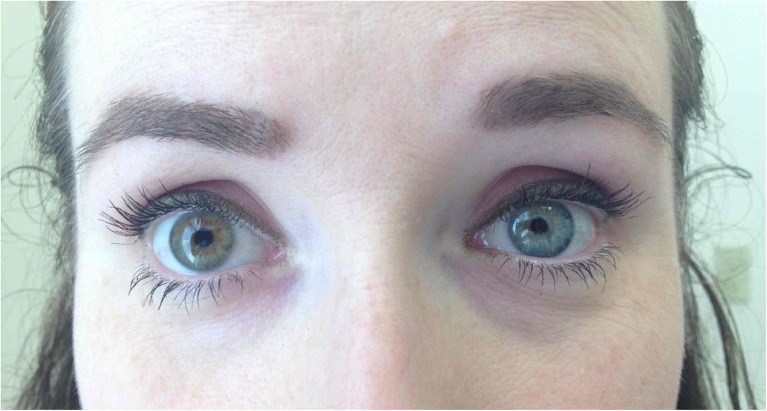A 37-year-old woman presented with papillary thyroid cancer as a complication of prior chest and neck radiation to treat a posterior mediastinal ganglioneuroblastoma, for which the patient underwent surgical resection as a child. The ganglioneuroblastoma obliterated the left second intercostal space and extended into the neck along the sympathetic chain, which was transected during resection, producing postoperative Horner’s syndrome. Additional late-onset complications of radiation treatment included mild aortic stenosis.
Physical exam revealed heterochromia iridis (Fig. 1), ptosis, and anisocoria. The patient also noted the absence of left facial and arm flushing with heat exposure, exercise, or consumption of spicy foods.
Fig. 1.
The patient’s affected left eye was different in color, with subtle pupil asymmetry and ptosis.
Horner’s syndrome produces the triad of ptosis, miosis, and anhidrosis due to damage to the ipsilateral sympathetic chain. The differential diagnosis is broad but should be driven by patient-specific factors. Congenital or acquired Horner’s syndrome in children can lead to heterochromia iridis.1–4 Sympathetic stimulation has a trophic effect on iris melanocytes, and denervation impairs melanin pigmentation, making the affected eye lighter.3,5–7 The patient's unilateral anhidrosis and absence of flushing was consistent with Harlequin syndrome, which is rare but can occur with Horner’s syndrome.8
This case exemplifies multiple complications of pediatric malignancy treatment and highlights the importance of cancer survivorship clinics, in which this patient was enrolled.
Acknowledgments
Conflict of Interest
The authors declare that they do not have a conflict of interest.
References
- 1.Ropper AH, Brown RH. 14: disorders of ocular movement and pupillary function. In: Ropper AH, Brown RH, editors. Adams and Victor's Principles of Neurology. 8. New York: McGraw-Hill Professional; 2005. pp. 222–45. [Google Scholar]
- 2.Renard D, Jeanjean L, Labauge P. Heterochromia Iridis in congenital Horner's syndrome. Eur Neurol. 2010;63(4):253. doi: 10.1159/000276946. [DOI] [PubMed] [Google Scholar]
- 3.Sayed AK, Miller BA, Lack EE, Sallan SE, Levey RH. Heterochromia iridis and Horner's syndrome due to paravertebral neurilemmoma. J Surg Oncol. 1983;22(1):15–6. doi: 10.1002/jso.2930220106. [DOI] [PubMed] [Google Scholar]
- 4.McRae D, Jr, Shaw A. Ganglioneuroma, heterochromia iridis, and Horner's syndrome. J Pediatr Surg. 1979;14(5):612–4. doi: 10.1016/S0022-3468(79)80152-9. [DOI] [PubMed] [Google Scholar]
- 5.Diesenhouse MC, Palay DA, Newman NJ, To K, Albert DM. Acquired heterochromia with Horner syndrome in two adults. Ophthalmology. 1992;99(12):1815–7. doi: 10.1016/S0161-6420(92)31720-8. [DOI] [PubMed] [Google Scholar]
- 6.Imesch PD, Wallow IH, Albert DM. The color of the human eye: a review of morphologic correlates and some conditions that affect iridial pigmentation. Surv Ophthalmol. 1997;41:S117–S123. doi: 10.1016/S0039-6257(97)80018-5. [DOI] [PubMed] [Google Scholar]
- 7.Gladstone RM. Development and significance of heterochromia of the iris. Ann Neurol. 1969;21:184–191. doi: 10.1001/archneur.1969.00480140084008. [DOI] [PubMed] [Google Scholar]
- 8.Guilloton L, Demarquay G, Quesnel L, De Charry F, Drouet A, Zagnoli F. Dysautonomic syndrome of the face with Harlequin sign and syndrome: Three new cases and a review of the literature. Rev Neurol (Paris) 2013;169(11):884–91. doi: 10.1016/j.neurol.2013.01.628. [DOI] [PubMed] [Google Scholar]



